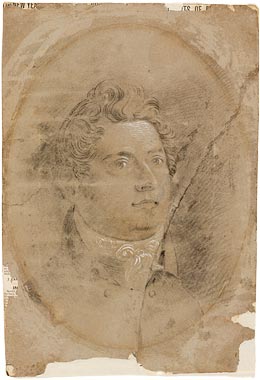Francis Greenway - convict architect

Francis Howard Greenway, Macquarie's architect, by unknown artist [possibly self-portrait]
Pencil sketch, GPO 1 - 21951 Ref ML 482
Francis Howard Greenway (born 1777 in Gloucestershire, England) had a promising career as an architect in the Bristol area until the firm went bankrupt. In March, 1812, Greenway was found guilty of the capital charge of forgery. His death sentence was commuted to 14 years' transportation to the colony of New South Wales. While awaiting transportation, Greenway spent time in Bristol's Newgate Prison.
> View Greenway's paintings of scenes inside Newgate Prison
Greenway arrived in Sydney in 1814 on the General Hewitt. He brought with him letters of recommendation and his portfolio which he sent to Governor Macquarie. He was almost immediately granted a ticket of leave which enabled him to seek his own work to support his wife and children who arrived in July 1814. In December Greenway advertised his architectural services in the Sydney Gazette.
> Read the Sydney Gazette advertisement from 1814
Soon after his arrival, Macquarie requested that Greenway copy a design for a court house from an architectural pattern book. Greenway replied by lecturing the governor on his poor taste in design and suggested that he himself should be employed as the governor’s public works architect. Although Greenway was eventually compelled to copy the design as originally requested, by early 1816 Macquarie was impressed enough by the cocky architect to appoint him Acting Civil Architect.
Governor and Mrs Macquarie had grand plans for the design and layout of Sydney town and an ambitious program of public and private buildings was begun in 1816. Francis Greenway’s commissions varied widely, from lighthouses to obelisks; churches to stables; barracks and prisons to private dwellings.
> Explore images of some of Greenway's buildings and monuments
Francis Greenway’s talent and his knowledge of architecture and design at first complemented Macquarie’s grand vision for a Sydney full of imposing and gracious buildings. His personal style, however, was often arrogant and insolent which irked his superiors. In 1819 Commissioner John Thomas Bigge was sent to Sydney to look into the affairs of the colony. Bigge was critical of the amount of time and money wasted on over-ambitious and unnecessary public works. He also commented on Greenway’s contribution to the architecture of the colony.
> Read selections from Bigge's report
During Bigge’s stay, the fragile relationship between the ambitious governor and the arrogant architect began to disintegrate. In November 1822 Greenway was dismissed from his post.
> Explore selections from Greenway's personal papers
Although he continued in private architectural practice Greenway never recovered his former prominence. He remained bitter about his treatment and wrote several articles and letters for the local press.
Francis Greenway died in 1837 on his farming grant and is buried in an unmarked grave near East Maitland. Despite this ignoble end, Greenway’s legacy lives on in some of Sydney’s finest colonial architecture.







